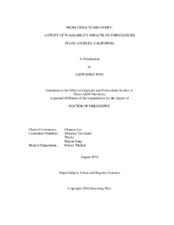| dc.description.abstract | Over the past decade, the literature has demonstrated negative price impacts for foreclosures; socioeconomically uneven foreclosure rates; and inconsistent durations in foreclosure status. However, while the evidence for sustainable benefits of walkable environments has been widely documented, the influence of built environments on such foreclosure-related activities has been largely neglected in the previous research. Using detailed data on foreclosed properties and transactions in the single-family housing market between 2008 and 2013 in Los Angeles, California, this dissertation examined if and how built environmental attributes (especially those supportive of neighborhood walkability) can moderate 1) price spillovers of foreclosures; 2) the density of real estate owned (REO) properties; and 3) the duration of REO status.
This dissertation consists of three stand-alone but interrelated studies. The first study objective provides an examination of current knowledge to assess price spillovers of foreclosures through a comprehensive literature review, and includes suggestions for future work and improvements. This review identified the various associations between neighborhood foreclosures and property values based on methodological differences across the literature in elaborating the foreclosure measurement while also managing control variables to deal with endogeneity problems. Additionally, the review illustrated different associations based on the heterogeneity of neighborhoods and housing markets.
To address the second study objective, the researcher utilized the Cliff-Ord spatial model to estimate the mitigation effects of neighborhood walkability (measured as Walk Score) on price spillovers of foreclosures. The negative spillover effects on property values were mitigated for those properties located in walkable neighborhoods, but only for middle-to high-income communities. Compared to the housing market crash period of 2010, the results showed greater advantages of neighborhood walkability during the recovery period of 2013 in terms of resiliency against negative price impacts.
The third study objective analyzes how walkable environments (as represented by residential density, land-use mix, and street connectivity measures) help reduce REO density, using the spatial regression model, and REO duration, using the Cox hazard model. With regard to REO density, safer neighborhoods and more accessible and diverse built environments appeared to be important for reducing the REO density measured at the census-tract level. With reference to REO duration, high-value REO properties in denser and more accessible neighborhoods were more likely to be sold, whereas low-value REO properties – particularly concentrated among low-income and minority communities – were less likely to be sold.
In conclusion, it is necessary to encourage walkability-related development strategies as one important policy measure to achieve neighborhood stability and livability. Further enforcement efforts tailored to enhancing environmental quality are also needed. More importantly, resolving disparities in environmental support for resiliency from foreclosure impacts is critical. | en |


